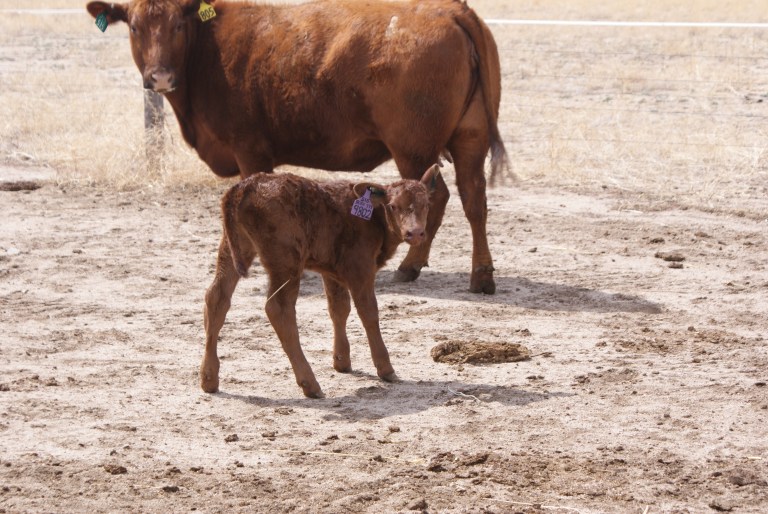Source: http://www.agonthe4front.com/difference-in-antibiotics-hormones/
In conversations about animal care and welfare, antibiotics and hormones often get bundled together. They are often associated with one another. But the truth is, they are two very different tools that ranchers and beef producers use. Let me explain the differences.
Hormones

Source: Alabama Cooperative Extension System
First and foremost, hormones occur naturally in beef. Hormones are products of living cells, so they are naturally in you, me, men, women, animals and plants.
When we talk about giving—or implanting—hormones to cattle, we are talking about natural hormones—testosterone, estradiol, and progesterone—and chemically similar synthetic hormones—melengestrol acetate, trenbolone acetate and zeranol. We use hormone implants in cattle to promote growth. We primarily administer growth hormones using a small, pelleted implant that is placed right under the skin on the back of the ear. It’s about the size of a small ibuprofen tablet and slowly releases the hormone over time. This ensures that hormone concentrations remain constant and low.
Implants create an increase in the growth-regulating hormones already naturally produced by the animal to increases muscle growth. This in turn increases feed efficiency, protein deposition and growth rate. Implanted calves usually result in a 10-20% increase in average daily gain (growth rate) compared to non-implanted calves. More important, as the growth hormone creates increased feed efficiency, less feed is required, which decreases production costs.
Since the hormone slowly releases over time, animal scientists and nutritionists know when the hormone will “run out,” so it will not be in the animal’s system before they are harvested. The U.S. Food and Drug Administration (FDA) has scientifically proven that hormones used in beef production is safe for humans to eat. We do not use growth hormones on our cow-calf ranch. Hormones are typically used in feedlots, where they are feeding an animal to become beef.
To dismiss the discussion topic that hormones in beef are causing early puberty in girls, there are many common foods that are naturally much higher in estrogen than implanted beef; cabbage, potatoes, peas—just to name a few. Check out the M&M example from my friend, Joan Ruskamp, and fellow beef producer, here.
Antibiotics

Source: Feed Yard Foodie
Antibiotics are a different tool than hormones, and we do use them on our ranch. If an animal is injured or has a bacterial infection, we will administer an antibiotic under the care of our veterinarian. And closely follow the label and dosing instructions, which are approved by the FDA. If my son is sick, I need a doctor’s prescription for an antibiotic. If our cattle are sick, we need a prescription from our veterinarian.
On our ranch, an antibiotic is given in the form of a shot. While there are other forms of antibiotics to help keep animals healthy and grow efficiently, administering a shot is the most common, and prevalent, use of antibiotics in livestock.
Most important for any antibiotic given to a food animal is its specified withdrawal time; the amount of time from when the shot was administered until it is out of the animal’s system. The maximum length of any withdrawal time is 28 days, so an animal on antibiotics must have completed the withdrawal period before being sold for slaughter. The USDA randomly inspects meat and there are safeguards to place to make sure our beef is safe.
An example when we would use an antibiotic on our ranch would be for respiratory disease—varying in severity from a common cold up to pneumonia. If we discover that the animal has a form of respiratory disease (we look for the same kind of symptoms as humans – cough, runny nose, weepy eyes, droopy ears – ok, so we might not have droopy ears!), we then work closely with our veterinarian to prescribe the animal an antibiotic that will help them get well. If that antibiotic’s withdrawal time is 28 days, we cannot sell that animal before the antibiotic is through their system and the withdrawal period expires. We take this very seriously, because not only is it law, it is how we assure we are producing healthy, safe and nutritious beef. And that is the only reason that ranchers like me use these antibiotics. Healthy animals = Healthy beef for all of us.
Antibiotics are just one way we care for our herd. We also care for them by giving them a good diet, medical care and healthy living conditions. My commitment to providing top-notch meat begins with top-notch animal care.
http://www.agonthe4front.com/difference-in-antibiotics-hormones/
Kelsey Pope is part of U.S. Farmers and Ranchers Alliance’s Digital Voices Council. To learn more about the program and bloggers who participate, click here.
Published with permission courtesy of http://www.agonthe4front.com/
